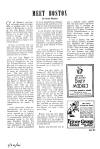
Click to enlarge.
Home Page Meet Boston Menu Index
|
MEET BOSTON Friday, January 24, 1941 in What's New In Town W. J. Sidis |
Of all Boston's old-time railroads, none has been able to endear itself to the hearts of Bostonians so much as the late Boston, Revere Beach & Lynn Railroad, better known by its pet name, the "Narrow Gauge." It got that name as having been "the only yard-wide railroad in the United States."
January 27 marks one full year that Boston has lost the services of the Narrow Gauge railroad. We are accordingly calling special attention to this railroad and its history.
The line from Boston to Lynn was started in 1871, as a low-fare competition for the old "Eastern Railroad," which also ran to a terminus on the East Boston waterfront and required a ferry from that point to serve as connection into town. The new road also served the growing beach district which had recently changed its name from Chelsea Beach to Revere Beach, and the growth of Revere Beach from then on was largely due to the little passenger trains that kept coming through, bringing people to and from Boston or Lynn. The narrow railroad, with its tiny trains and almost miniature locomotives, was an interesting sight as well as useful transportation for nearly 70 years.
A few years later, when experimenting with electric transmission of the human voice, carried on in various parts of the world resulted in a commercially practical instrument made in an attic near Bowdoin Square, the Narrow Gauge became the first railroad in the world to see in it a useful equipment for train despatching, thereby improving the operation of the road as well as promoting the general use of the telephones.
In the Nineties, the acquisition of a branch loop to Winthrop completed the Narrow Gauge system by giving that suburb its only regular transportation; this was supplemented by a puffing gasoline car that gave service to Point Shirley.
To several generations of Bostonians, the Narrow Gauge was the gateway to a fine day at the beach in summer, and Narrow Gauge trains and ferryboats have worked themselves into Boston's heart, and will be missed by hundreds of thousands for a long time to come.
When the day came, on
[Saturday] January 27, 1940, that the road was
finally closed down, there was almost an atmosphere of mourning in
Lynn, Revere, and Winthrop, and people came in from as far
as the White Mountains to say goodbye; while, from New York to San
Francisco, Bostonians and people who had spent some time in Boston,
found regret at the loss of an old and dear friend. The darkened
building of Rowes Wharf, the empty East Boston ferry slip, the unused
tunnel, the boarded up stations, still bear witness to an emptiness
that Boston will take a long time filling. * Boston was the first large city east of Chicago to
have streamlined trains. It is the only large city anywhere to use
streamlined trains for commuting service.
Boston was the first city to use a special traffic signal (the red and yellow
lights) to indicate that a crossing is freed of vehicular traffic for
pedestrians to pass. Nowhere outside Massachusetts is so much
allowance made for pedestrians in the traffic signal system.
It was in Boston that
the new electric-welding process first replaced the old-fashioned noisy riveting still used
in New York and other cities for erecting steel buildings. This new
process was used for putting up a new annex to Boston's City Hospital,
where avoidance of noise was important.